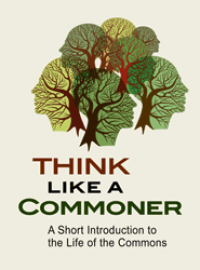When copyrights are claimed for the basic elements of a creative field, you can be sure that future creativity will suffer. That’s because sharing and recombination lie at the heart of a robust culture. Making sharing and recombination illegal is no way to invigorate creativity.
The latest case in point is a lawsuit filed by the renowned glass artist Dale Chihuly against two glassblowers, one a former employee, who dared to create glassworks that resembled his. Many of Chihuly’s works are inspired by the waves, ripples and colors of the ocean. His chandeliers, decorative sculptures and installation pieces range in price from hundreds to millions of dollars.
The question explored by Timothy Egan in yesterday’s New York Times is whether Chihuly can use copyright law to prevent other glassblowers from making glass-blown works in “his” style — that is, with the kinds of waves, ripples, colors and lopsided design features that have been associated with him. Can one person’s abstract inspirations from nature be owned?
To adjudicate such questions, copyright law has historically relied upon what it calls the idea/expression dichotomy. This is a mental construction that conceptually separates an idea, which cannot be owned, from a specific expression, which can be owned. Unfortunately, this doctrine does not really provide much guidance when an idea and expression are wholly intertwined. Think of the opening notes of Beethoven’s Fifth Symphony. It’s hard to know how to communicate the “idea” of those opening notes (legal) without also communicating their particular expression (illegal).
In this case, the defendants point out that “lip wraps and ripples” are two standard design elements in blown glass art that “have been around for centuries.” The Times story also cites a copyright case that went before the Ninth Circuit Court of Appeals in 2003, in which one artist said that another artist had imitated his design of a jellyfish encased in glass. The Court ruled: “These ideas, first expressed by nature, are the common heritage of humankind, and no artist may use copyright laws to prevent others from depicting them.” But the Court also said that an artist may “protect the original expression he or she contributes to these ideas.”
The empirical question in Chihuly’s case may be whether his work is “original” enough to merit copyright protection. (Ironically, Chihuly has not been able to blow glass for 27 years, because of two accidents, so a team of 93 employees are the ones who actually execute Chihuly’s artistic ideas.)
The lawsuit strikes me as an attempt by Chihuly to assert a de facto monopoly over his genre of art. It reminds me of the attempt by the estate of Alexander Calder to prevent anyone from thinking that other artists might also make mobiles. As a condition for loaning a collection of 270 Calder works, the Calder estate pressured museums to banish from their gift shops any mobiles made by other artists. An arts administrator likened the estate’s demand to an artist saying, “Don’t use acrylic paint because I’m the first artist to use it.”
I’m also reminded of a remarkable story told to me by Robert Graham, the sculptor. He said that the Catholic Church in Los Angeles had asked him to copyright his stunning Great Bronze Doors of the Cathedral of Our Lady of the Angels — and then to give it the Church as part of his commission. As an artist, Graham stoutly objected. He ultimately prevailed when he pointed out that if the Catholic Church had asserted a copyright or trademark over the Virgin Mary, he never would have been able to create the Great Bronze Doors in the first place.
The Doors draw upon more than 40 different symbols from antiquity — pre-Christian images from Europe, Asia, Africa and North America such as the eagle, griffin, goose and Southwest Indian Flying Serpent. They also include European visions of the Virgin filtered through the style of indigenous cultures that Europeans forcibly Christianized. “This interweaving of traditions and image sources activates the imagination of visitors from many parts of the world, at the same time linking them to a shared religious experience,” writes John O’Brien,.
Now imagine if some or all of these motifs were locked up by trademarks or copyright law. Nothing new could be produced. The emotional feelings, historical associations and artistic references of prior works could not be invoked. The palette available for new artistry would be seriously diminished. The artistic vigor of any new creation would be compromised from the start.
This is why the idea of “market culture” can be something of an oxymoron. Markets are about exclusive ownership of creative works (re-defined as “intellectual property”). Markets may help disseminate works more broadly, but they can also take basic elements of creativity out of circulation (ostensibly for a limited time, and with exceptions for fair uses). By contrast, a rich culture requires a large, unmetered design commons to facilitate sharing and recombination. Once copyright law begins to privatize and lock up the basic design palette of a field, its vitality is put in jeopardy. One can only hope that Mr. Chihuly will acknowledge his own reliance on nature and prior artists, and allow his works to become a rich source of inspiration for others in the future.











Recent comments